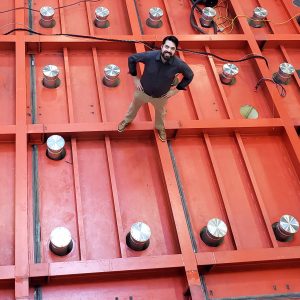
Ph.D. student Chris Hilbgenberg is exploring the basic structure of the physical universe, while having to deal with problems from outer space.
Hilgenberg is a 6th year Ph.D. student studying experimental neutrino physics and currently working at Fermilab, a national particle physics and accelerator laboratory located outside Chicago. In 2015, he joined the ICARUS collaboration, led by Nobel Laureate Carlo Rubbia, as part of the Short Baseline Neutrino (SBN) Program. Chris’ thesis advisor, Colorado State University Prof. Bob Wilson, was recently appointed as deputy leader coordinating the U.S. groups and interim chair of the collaboration Institutional Board.
Understanding whether or not there are sterile neutrinos is relevant to important details about how we understand the physical universe at its most basic level. This science is a challenging undertaking, as cosmic rays naturally coming from space complicate experiments by interfering with streams of particles.
Hilgenberg is involved in the development, production, and testing of important components of the ICARUS T600. He also is working on the solution to the cosmic ray problem – an extra analysis step to track and remove the effect of the cosmic rays. The ICARUS project is one of the flagship experiments of the Short Baseline Neutrino Program, and Chris’ contributions are an important part of this work.
Hilgenberg received one of the 2016 American Physical Society Four Corners awards for best talk by a grad student. The talk was based on the research and development work on a new cosmic ray tagging system (CRT) for ICARUS. He is also a two-time recipient of the University Research Association’s Visiting Scholar Award for faculty and students posted at Fermilab. The award supports his work on the ICARUS hardware and simulation.
While Chris enjoys his experience at Fermilab, he misses the cozy atmosphere of the physics department at CSU and the breathtaking scenery of the foothills. “I enjoyed interacting with the students and leading recitation sections,” he says. “Plus, going for a day hike was a great way to reset when stuck on a problem.
